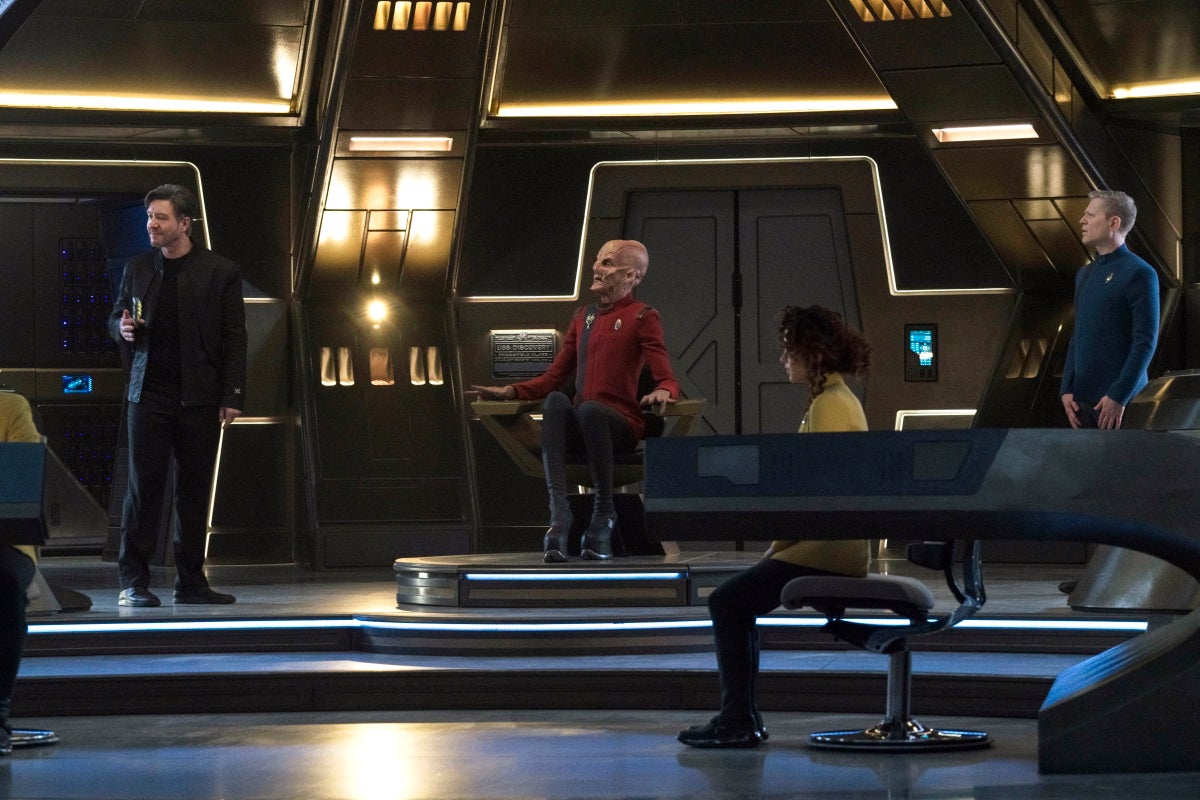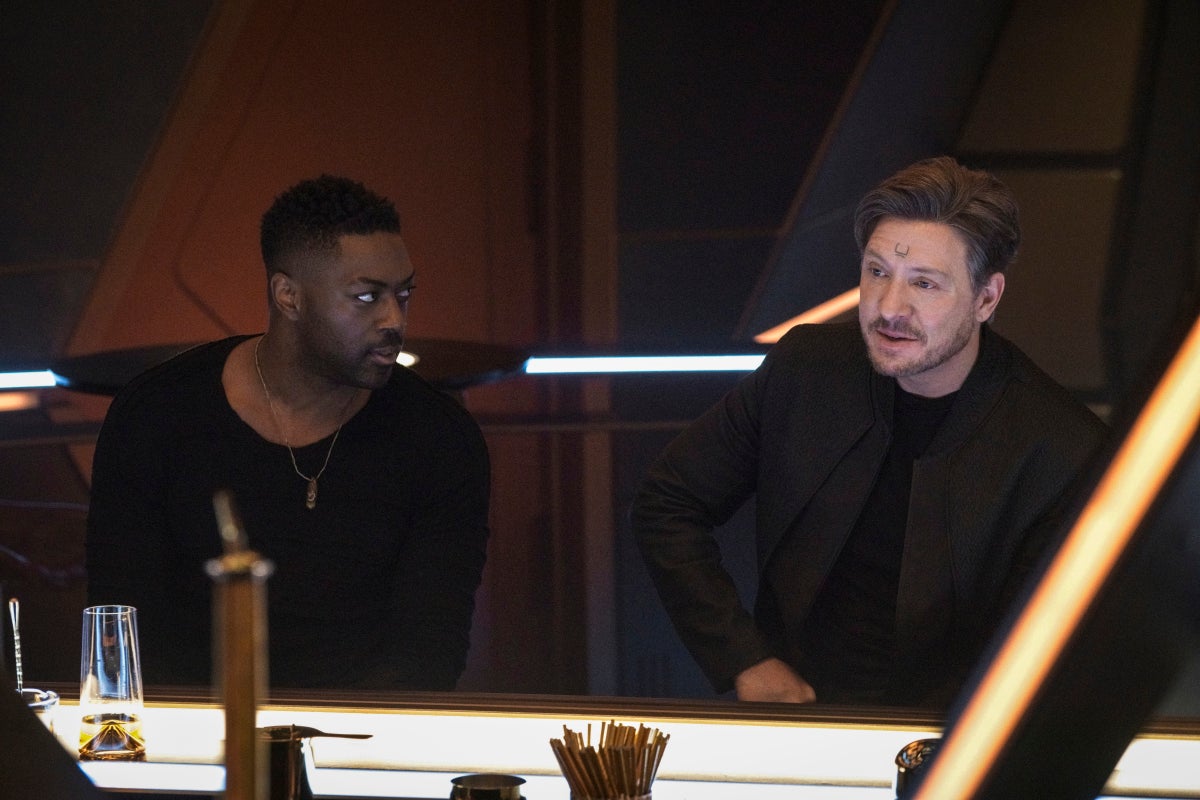Star Trek: Discovery has been a little emotionally all over the place in its most recent season — more than usual, as it’s pushed and pulled its put-upon Starfleet heroes from one crisis to the next, while also occasionally stopping to let them vent their pent-up feelings. But this week was different. This week, for the most part, the crew just got to have some fun.
Until they didn’t, of course.

“The Examples” follows in the footsteps of the kinds of stories we’ve had so far this season — tales that are connected to the wider season-long threat of the Dark Matter Anomaly, but not entirely about it. This week was more connected than most: the primary plot follows the Discovery on a rescue mission to a colony world about to be in the path of the DMA, and its secondary sees a confounded Stamets forced to team up with an irascible Risian scientist, Ruon Tarka (Shawn Doyle), to make process on exploring the true origins of the anomaly. Save for some late-game revelations — more on those later — both of these plots aren’t really about the DMA however, and are instead once again a chance for Discovery to capably prove that it can riff on some classically Star Trek episode premises. And it does so, for the most part, pretty acceptably.

The main plot sees Burnham and Book beam down to the Akaali colony (a fun throwback itself to a species introduced in Enterprise) to begin evacuating civilians — only for them to discover six lifeforms who haven’t responded to Starfleet hails to relocate to evacuation points. It turns out those six are the titular Examples: the only indefinite prisoners in the colony’s justice system who have been left locked up for their lives, no matter how insignificant their crime is, to set a harsh (and, we’re told, effective) example to the other colonists about crime and punishment. Naturally, Burnham and Book can’t stand by and leave these people to die a horrifying death if the DMA crosses the colony’s path, and we are off to the races. Star Trek just absolutely loves itself an alien justice system it can directly interfere in, and Discovery even throws in some fun banter, weird exploding beetle mines, and an ethical dilemma sob story for good measure, when Burnham discovers one of the prisoners she’s about to offer political asylum to is actually a murderer.
As fun and classically Trek as this is, it’s not without its problems. Discovery has been, in fits and starts, a show that has been fascinated with, but rarely quite so willing to question, the nature of what Starfleet should be in its contradictory existence as a exploratory peacekeeping taskforce. So just having Michael act like so many Trek heroes before her and bludgeon her way through the ethics of the Akaali justice system without any self-reflection on that — and for her to be framed as a kickass hero for doing so — just feels a little weird, and pushes us to the limits of what happens when a contemporary show like Discovery just tries its hand at riffing on premises that have worked for Star Trek in the past. There’s nothing really new Discovery has to say about this format, and in the end, any ethical quandary Michael might feel for her actions — whether or not she is willing to grant asylum to a killer to protest the inequality of the Akaali’s penal system — is taken out of her hands when the prisoner chooses to stay behind as something of a martyr, perishing as the sole victim of the colony’s destruction by the DMA. All that’s left is Discovery’s penchant for overwrought emotion, as a tearful Michael is left sitting on the bridge while the prisoner clunkily plot dumps his backstory waiting for his oblivion. No real lessons learned, no ideas challenged, in the moment is fine, and as we said, fun — exploding beetle mines! — but after a few episodes of Discovery going back and doing these riffs, it starts to feel a little empty.

What doesn’t, for good and ill, is the side plot with Stamets and Tarka. Tarka himself is likewise ripped from the big book of Star Trek story tropes: the arsehole guest scientist who comes aboard the ship and bristles with our own scientists. This is made more interesting, momentarily, in the fact that Stamets is — despite plenty of softening over the last four years — still a little bit of an arsehole himself, making for some fun interactions between himself and Tarka as he slowly picks up that, for all the man annoys him with his genius and overconfidence, they’re much more like each other than he initially wanted to admit. It’s a nice “lesson” for Stamets to have, even as Discovery has gone great lengths to move him away from his original prickly self over the years by expanding upon his relationship with Dr. Culber, or giving him a father-figure role with Adira. Watching him reflect on who he’s become over the last four years (or several thousand, give or take a bit of time leaping in season two) is far more genuinely touching that the melodrama of Michael’s connection to the Akaali prisoner in the A-plot, and a still-rare example of Discovery doing some great character building with someone who isn’t Michael herself.
However, where “The Examples” moves away from its empty but enjoyable fun and into something much more serious and messy is also in this arc, as Stamets and Tarka make a pretty major discovery about the DMA. It is not, as they had previously theorised, a natural disaster on an intergalactic scale. Their tests together confirm that not only is it artificially made, but being controlled by an unknown, impossibly advanced being or civilisation who is directly manipulating where the DMA moves to, uncaring for the destruction left it its wake. It’s a twist to be sure, and one made all the more twistier when the episode ends with an all-the-subtlety-of-a-brick reveal that Tarka himself might not just be up to no good in worming his way onto Discovery, but seemingly knows much more about the true origins of the DMA and who’s behind it than he’s letting on. But it’s also hard not to feel a little disappointed that Discovery finds itself once again confronting a personal, targeted threat as the big bad of the season with this reveal.

From the Klingons to Control, and Osyraa and the Emerald Chain last season, Discovery has done plenty with the idea of a powerful force or character that has it out for the Federation. Part of what made the DMA so interesting on a conceptual level was that it is this natural disaster — you can’t reason with a gravitational force that just floats through space flinging stations and colonies around and wrenching planets apart, you can’t fight it in a starship or with a phaser. A natural disaster’s not a “good versus bad” plot, but one that has so far let the show this season be about the sorts of things we want to see Starfleet heroes doing — disaster relief, scientific exploration, delivering hope. Discovery has plenty of time left this season to keep doing that, as it has in this first half, but that we now seemingly are heading towards yet another of those mysterious villain premises that we’ve seen the show do over and over, it’s hard to say just how much longer we’ll get to see that interesting side of Discovery before it’s back to the same narrative threads it has tugged on before.
Wondering where our RSS feed went? You can pick the new up one here.
